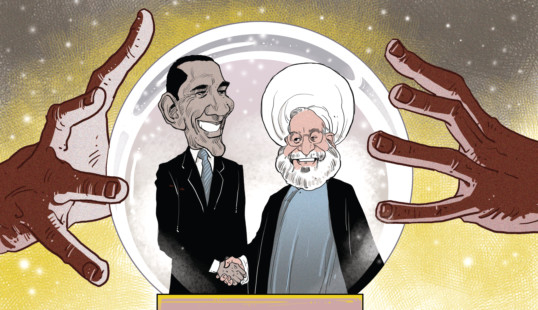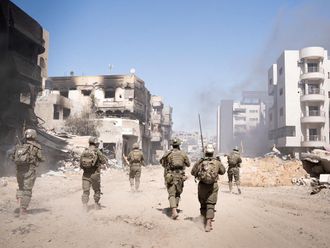
The political leadership in Iran and the US want a nuclear deal and appear confident that they can reach at an agreement. The four-month extension they gave themselves last week was not an indication of failure, but simply a recognition that they needed more time.
Both sides are saying that the other must make “hard choices” for a deal to be made, but during six rounds of intensive talks in Vienna this year, including the 17-day marathon that ended last week, both sides showed flexibility on key issues.
Both sides have to work to overcome decades of deep suspicion. The Iranians feel that the P5+1 group (US, Britain, France, Russia, China + Germany) is more interested in cutting back the Islamic Republic’s regional and global influence and the Americans fear that Iran is playing them for short-term gain in getting the debilitating sanctions lifted.
Therefore, finding a solution will require trust from both sides and all the time spent negotiating may have encouraged the participants to take that major diplomatic leap of faith. When they announced the four-month extension, Catherine Ashton, High Representative for Foreign Affairs and Security Policy for the European Union, and Mohammad Javad Zarif, the Iranian Foreign Minister, said: “We will reconvene in the coming weeks in different formats with the clear determination to reach agreement at the earliest possible moment.”
It is unfortunate that both sides are stuck in a numbers war in public over how many uranium enrichment centrifuges would be acceptable. Today, Iran has just under 10,000 centrifuges and the US and its allies seek a “significant reduction” and have spoken provocatively of numbers between 500 to 1,200. But Iran’s Supreme Leader Ayatollah Ali Khamenei spoke a few weeks ago about Iran’s “absolute need” for 100,000 centrifuges and that this was necessary to provide fuel for the country’s power reactor when a Russian supply contract expires in seven years.
It is an absolute requirement for the Iranians that they keep their capacity to enrich and create their own nuclear fuel for their reactors. Iranian officials say any “dismantlement” of current enrichment capacity or a permanent cap on future advances will be seen as an unacceptable defeat at home. This capacity to enrich is vital for Iran because it has bitter experience on not being able to trust foreign fuel supply. Iran had an agreement with Russia to obtain nuclear fuel for the Bushehr nuclear power plant, but from 2005-2007, the Russians manipulated the supplies to put pressure on the Iranians in order to get them to stop enrichment.
Growing trust
However, there are ways round this apparent impasse over numbers and compromises are being discussed. Gareth Porter, a respected analyst, has reported that the Iranians seem ready to agree to some kind of compromise in which they would wait for some years before they begin to move to an industrial-scale enrichment capability, although the US at this moment appears not to be prepared to agree to this.
Porter quoted a possible compromise put forward by thinkers at Princeton University that would involve a two-stage solution, by inserting into the agreement a provision that would put off the decision about a longer-term enrichment capability for six to eight years. Then it may be possible for the US to have more trust of Iran and for the Iranians to have more trust that they are not going to be cheated or manipulated by the P5+1.
The growing trust between the two sides is supported by the International Atomic Energy Agency’s (IAEA) monthly reports that repeatedly confirm that Iran is fulfilling its commitments. Iran has neutralised its entire 20 per cent enriched uranium stockpile and limited its five per cent stockpile; allowed enhanced IAEA inspection of its nuclear sites, including the disputed Natanz facility; refrained from installing newly developed centrifuges; and has made no new advancements at the Arak nuclear facility. Even John Kerry, the US Secretary of State, has agreed that real progress had been made on several key issues, including on the Fordow and Arak nuclear facilities, stockpile of low-enriched uranium, enhanced monitoring and verification, research and development and the potential military dimensions of Tehran’s nuclear programme.
Sell the deal
This will help make the deal more sellable in Washington. High on the agenda for both the US and Iranian negotiators is being able to go home with a deal that they can sell to powerful hardliners. As Ellie Geranmayeh of the European Council on Foreign Relations points out, the nuclear programme is a source of extensive national pride for Iran’s government. While Iran is wiling to compromise on its enrichment production lines and enhanced inspection, the idea that it would have to dismantle its centrifuges and accept tight restrictions on research is perceived by Iran as humiliating and unacceptable.
Meanwhile, the US administration has to contend with those who are opposed to any diplomacy with Iran, particularly Israel and powerful forces in Congress, who, throughout the talks, have been calling for fresh sanctions and placing unreasonable limitations on Iran’s nuclear programme in order to kill the deal.
The counter argument is that a comprehensive nuclear deal is vital to meet concerns over nuclear proliferation since the other options (sanctions or military strikes) cannot stop Iran from developing a weapon if it wants to and can only slow that process down.









